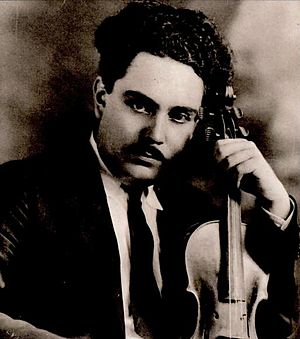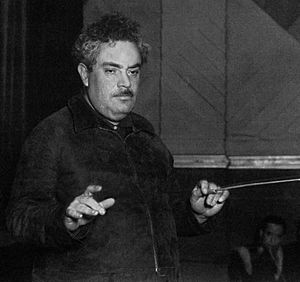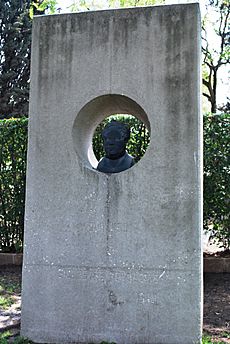Silvestre Revueltas facts for kids
Silvestre Revueltas Sánchez (born December 31, 1899 – died October 5, 1940) was a famous Mexican composer of classical music. He was also a talented violin player and a conductor (someone who leads an orchestra).
Contents
About Silvestre Revueltas's Life
Silvestre Revueltas was born in Santiago Papasquiaro, a town in Durango, Mexico. He loved music from a young age. He studied at the National Conservatory in Mexico City. He also went to schools in the United States, like St. Edward's University in Austin, Texas, and the Chicago College of Music.
After his studies, Revueltas performed many violin concerts. In 1929, a famous Mexican composer named Carlos Chávez invited him to join the National Symphony Orchestra of Mexico. Revueltas became the assistant conductor. He worked there until 1935. Both Revueltas and Chávez worked hard to share new Mexican music with the world.
Around this time, Revueltas started writing a lot of his own music. He began his first film score, Redes, in 1934. This project caused a disagreement between Revueltas and Chávez. Chávez had expected to write the music himself. However, changes in the government led to Chávez losing his job at the Ministry of Education, which was involved with the film. In 1935, Revueltas left Chávez's orchestra. He became the main conductor of a new orchestra called the Orquesta Sinfónica Nacional, but it did not last long.
Silvestre Revueltas came from a very artistic family. Many of his family members were also well-known in Mexico. His brother Fermín and sister Consuelo were painters. His sister Rosaura was an actress and dancer. His younger brother José Revueltas was a famous writer.
Silvestre's daughter from his first marriage, Romano Carmen, became a successful dancer. She taught ballet and flamenco in New York. His daughter from his second marriage, Eugenia, is an essay writer. His nephew, Román Revueltas Retes, is a violinist, journalist, painter, and conductor.
In 1937, Revueltas traveled to Spain during the Spanish Civil War. He was part of a tour organized by a group called the Liga de Escritores y Artistas Revolucionarios. After the war ended, he returned to Mexico. Silvestre Revueltas passed away on October 5, 1940. His remains are kept in the Rotonda de los Hombres Ilustres in Mexico City. This is a special place for famous people in Mexico.
What Kind of Music Did Revueltas Write?
Revueltas wrote many different kinds of music. He composed music for films, chamber music (music for small groups of instruments), and songs.
His most famous work is often considered to be Sensemayá. This orchestral piece is a masterpiece. Another well-known work is the 1960 arrangement of his film score for the 1939 movie La noche de los mayas.
Revueltas even appeared briefly in a movie! He played a bar piano player in ¡Vámonos con Pancho Villa! (Let's Go with Pancho Villa, Mexico, 1935). He also wrote the music for this film. In one scene, when shooting starts in the bar, he holds up a funny sign that says, "Please don't shoot the pianist."
Chamber Music Pieces
Chamber music is written for a small group of instruments.
- El afilador, 1924
- Batik, 1926
- Four Little Pieces for two violins and cello, 1929
- String Quartet No. 1, 1930
- String Quartet No. 2, 1931
- String Quartet No. 3, 1931
- String Quartet No. 4, Música de feria, 1932
- Tres piezas, for violin and piano, 1932
- Tres pequeñas piezas serias, for a group of five wind instruments, 1932–33
- Ocho x radio, 1933
- Planos, 1934
- Homenaje a Federico García Lorca, 1936
- Éste era un rey, 1940
- First Little Serious Piece, for chamber group, 1940
- Second Little Serious Piece, for chamber group, 1940
Orchestral Music Pieces
Orchestral music is written for a large orchestra.
- Pieza para orquesta, 1929
- Cuauhnáhuac, for string orchestra, 1931 (later changed for full orchestra)
- Esquinas, 1931
- Ventanas, 1931
- Alcancías, 1932
- Colorines, for chamber orchestra, 1932
- Janitzio, 1933
- Toccata (sin fuga), for violin and chamber orchestra, 1933
- Troka, 1933
- Caminos, 1934
- Danza geométrica (orchestral version of Planos), 1934
- Sensemayá, 1938
- Itinerarios, 1938
- Música para charlar, 1938 (from a film score)
Ballets
Ballets are stories told through dance, usually with music.
- El renacuajo paseador, 1936
- La coronela, 1939 (this piece was not finished by Revueltas)
Film Scores
Revueltas wrote music for many movies.
- Redes, 1935
- ¡Vámonos con Pancho Villa!, 1936
- El indio, 1938
- Ferrocarriles de Baja California, 1938
- Bajo el signo de la muerte, 1939
- La noche de los mayas (Night of the Mayas), 1939
- Los de abajo, 1940, directed by Chano Urueta
- ¡Que viene mi marido!, 1940
Songs
- Duo para pato y canario, for voice and chamber orchestra, 1931
- "Ranas" (Frogs) and "El tecolote" (The Owl), for voice and piano, 1931
- Caminando, 1937
- "Canto a una muchacha negra" (words by Langston Hughes), for voice and piano, 1938
- Cinco canciones para niños y dos canciones profanas, 1938–1939
Piano Pieces
- Adagio
- Tragedia en forma de rábano (no es plagio)
- Allegro
- Canción
See Also
- Daniel Ayala Pérez – another musician who studied violin with Revueltas
 In Spanish: Silvestre Revueltas para niños
In Spanish: Silvestre Revueltas para niños
Sources
- Palencia Alonso, Héctor. 2000. "Voces magistrales: Silvestre Revueltas". In Conservatorianos: Revista de información, reflexión y divulgación culturales 6 (November–December): 25–29 (Archive from 2 November 2011, accessed 2 July 2014).





